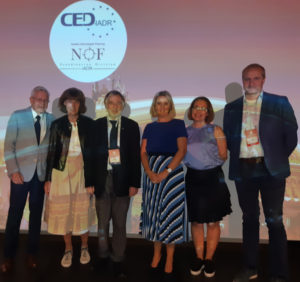Symposium: Dental erosion – the new toothache CED/NOF-IADR congress, Madrid
Posted 10/01/2019

The three-part symposium “Dental erosion – the new toothache” was sponsored by Nordisk Odontologisk Förening (NOF), the Scandinavian Division of the International Association for Dental Research (IADR) and Nordic Institute of Dental materials (NIOM).
The symposium gave an overview of the prevalence, risk indicators and non-invasive treatment of dental erosive wear, based on clinical cases and supported by scientific literature.
Aida Mulic from NIOM, Oslo, Norway, opened the symposium with the presentation “Dental erosive wear-a global condition”. Tooth wear is the results of interacting processes: abrasion, attrition, erosion, and possibly abfraction. The most important interaction seems to be the potentiation of abrasion by erosive damage to the dental hard tissues. Therefore, dental erosive wear is considered to have the combined effect of chemical dissolution of tooth surface caused by acids and mechanical wear of the acid-softened surface. Mulic gave an overview of the prevalence of the erosive tooth wear, which is high, particularly among children and adolescents. Even though different epidemiological survey data are difficult to compare and the actual global prevalence may be difficult to estimate, there seems to be a gender difference and an increase in prevalence with age.
Next speaker, Viivi Alaraudanjoki from Research Group of Oral Health Sciences, University of Oulu and Finnish Student Health Service, Oulu, Finland, dove into the latest research on the “Etiology of erosive tooth wear and risk assessment“. Previously has erosive tooth wear been considered as a simple condition, and causes of dental erosion have traditionally been categorized into acids of extrinsic or intrinsic origin. Therefore, the conception of erosive tooth wear has recently been changing towards a complex interplay between chemical, mechanical and biological factors. It is indicated that in particular the chemical properties of acids and the frequency of acidic challenges play an important role in the pure erosion process. Considering the lifestyle and eating and drinking habits of modern individuals it is important to know which products are erosive and which are not. Considering the amount of potentially erosive products and their properties, basic guidelines are needed to assess the erosive potential of different products. In addition, recent studies have shown that the genetic variation may also explain an individual`s susceptibility to dental erosive wear. However, it seems unlikely that one or two isolated factors are responsible for a multifactorial condition. It was pointed out that risk assessment of erosive tooth wear is another issue that is often difficult and time-consuming. Alaraudanjoki mentioned also that recent studies have shown the Basic Erosive Wear Examination (BEWE) to be a useful tool in assessing the risk for erosive wear.
To conclude the symposium, Ulla Pallesen from the Department of Odontology, Faculty of Health and Medical Sciences, University of Copenhagen, Denmark and Torgils Lægreid, Department of Clinical Dentistry – Section of Cariology, University of Bergen, Norway, talked about “Non-invasive restorative treatment of warn teeth”. It was stated that non-physiological and pathological wear may require restorative treatment out of concern for biological perspectives, though most often to accommodate a patient’s aesthetic needs. These kinds of treatment have often involved extensive prosthetic reconstructions with immense implications for the pulp, the marginal periodontium and not least for the patient’s economy. Today, adhesive technology has allowed for restorative solutions that, following non-invasive additive principals, may be adapted to the teeth’s and the individual patient’s need. The lecture gave an overview of indications and different methods for treatment with and without increasing the vertical dimension of occlusion and orthodontic pre-treatment of dental wear. The focus of the lecture was mainly on the reconstructions where non-invasive adhesive treatment with direct resin materials and, in some cases, ceramic laminate veneers is used. A summary of the longevity of treatments and recommendation of measures to optimize the longevity using different non-invasive strategies was given.